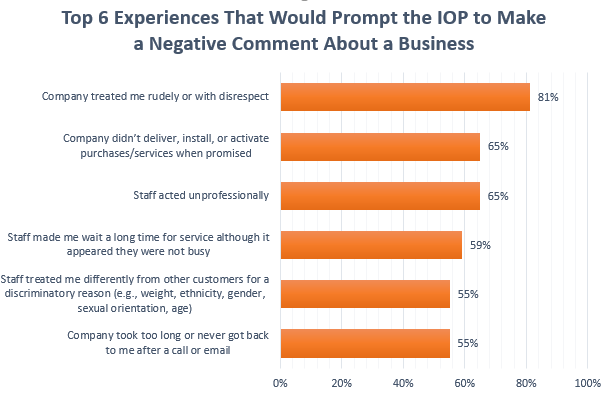Over the last few years, customer journey mapping and evaluating customer experience has been a hot topic in many industries. However, sometimes companies may wonder if the effort and cost of such an initiative is worth it. Will they see an equal return on investment in revenue, customer retention, referrals, or stock price?
One thing is certain and might convince you to investigate your customer experience: word-of-mouth is always at the top of the list when we ask consumers or B2B buyers about their trusted information sources. Whether it is shared online, in person, or through a formal referral, people rely heavily on word-of-mouth opinions when making purchase decisions. If for no other reason than this, you should pay attention to your customer experience.
We all get irritated sometimes when dealing with companies, websites, sales clerks, and deliveries, yet we do not always translate that irritation into disparaging the company. We were curious to know what types of experiences would prompt consumers to share negative comments about a business or organization, either in conversation or online. We asked 1,707 of our Iowa Opinion Panel members if any of 19 different customer experience scenarios would lead them to openly criticize a business or organization.
Overall, the key pain points that would motivate negative comments revolved around issues of feeling disrespected or a company’s failure to meet promises or respond promptly. Following were the top reasons from the October 2017 survey:

All of the scenarios we asked about were selected by some participants as likely to result in negative comments, but those least likely to hurt a company’s reputation were:
- Company did not contact me after purchase (3%)
- Staff dressed unprofessionally (16%)
- Company contacted me too much after purchase (23%)
- Staff announced my credit/debit card had been declined where others could hear (24%)
- My experience was different than advertised (24%)
Customer differences. There were many gender and generational differences seen in the results of the survey. Men were more likely than women to talk negatively if company service went downhill after purchase or their experience was different than advertised. Women were more likely than men to be upset enough to talk negatively by being treated rudely, having difficulty making exchanges or canceling services, feeling unwelcome because of who they were with (baby or special needs child), feeling discriminated against, and having their card decline announced loud enough that others can hear.
Overall, your older customers may be more likely to speak negatively about you under many circumstances. The older survey participants, especially those 50 and older, were more likely to say they would do this under all of the scenarios we tested, with the exceptions of feeling unwelcome because of a baby or special needs child or feeling discriminated against. The youngest participants were the most sensitive to being treated differently than others based on a discriminatory reason (gender, ethnicity, weight, sexual preference, etc.)
Other irritants. The survey participants had an opportunity to type in other situations that would get under their skin. We had a number of write-in comments, with most involving experiences where they or others were being ignored or disrespected or situations where they had to deal with poor quality products or sub-par performance. Several people noted they do not make negative comments online as a rule, but that does not mean they are not sharing negative comments in other ways.
Undoubtedly, you have heard the claim that when one upset customer tells another person about their bad experience, between 10 and 20 people hear negative comments about the business by word-of-mouth. That kind of ripple effect could cause a company to lose customers or discourage some interested consumers or corporate buyers from giving them a try.
If you have not initiated an evaluation of your customer experience and a plan for making it the most convenient and positive journey possible, consider dedicating resources to an effort starting in 2018. When you start you research, be sure to focus on how customers felt they were treated at various touchpoints as well as examining your metrics on staff response time, customer complaint resolution, and delivery or other deadlines. Those appear to be the areas most likely to initiate poor word-of-mouth.
If you would like the full results of the survey referenced in this article, or are interested in talking about how to evaulate your customer experience, contact Linda Kuster, no obligation, at lkuster@vernonresearch.com or 319-364-7278, ext.7104
![]()

